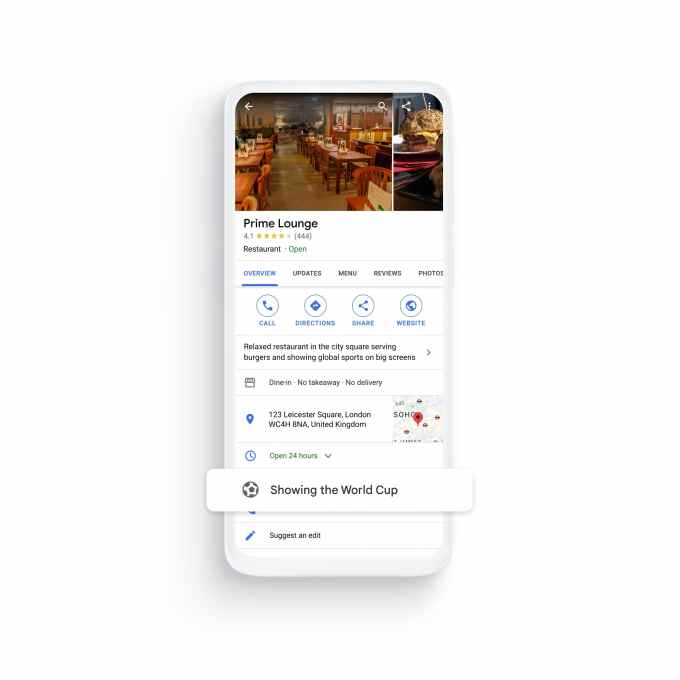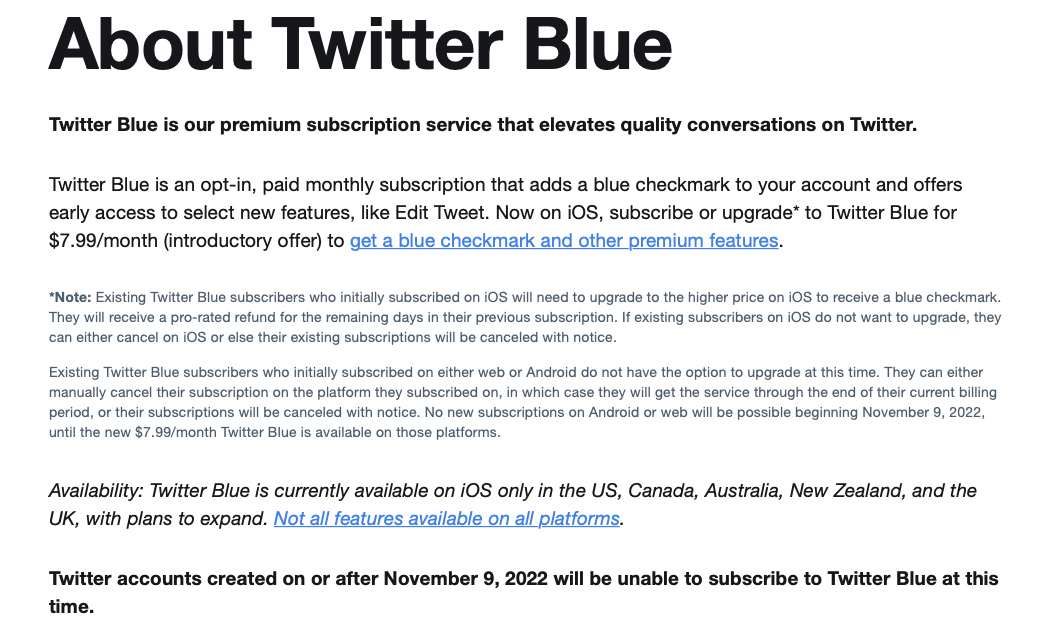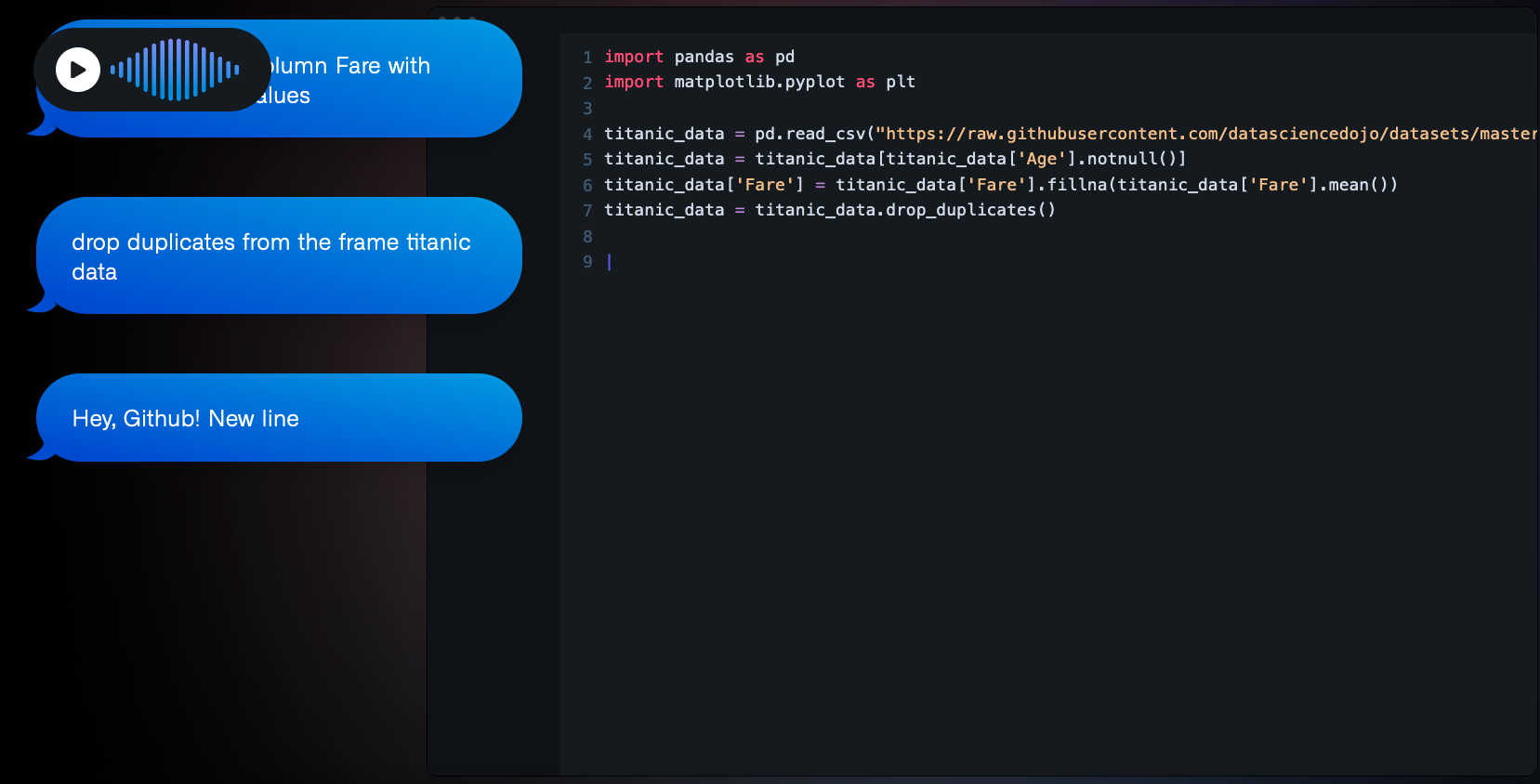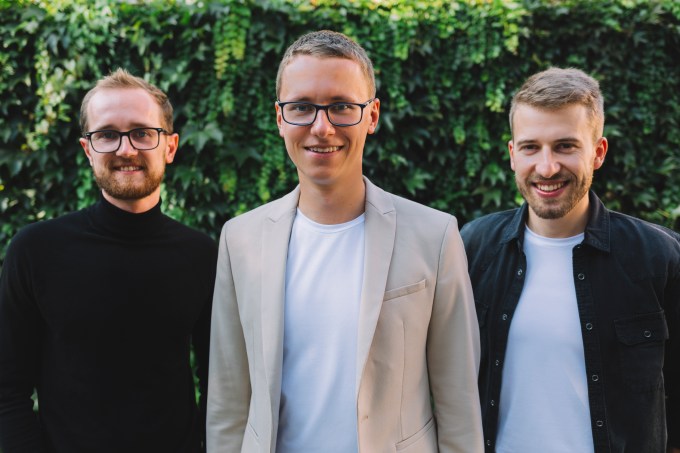Category: TECHNOLOGY
Twitter blocks new accounts from its $8 verified tier after high-profile fakes abound
The motto over at Twitter is clearly a throwback ‘move fast and break things’ at the moment under new ruler Elon Musk, and the latest thing to break is the just-introduced $8 monthly Twitter Blue tier, which includes a shiny ‘verified’ checkmark indistinguishable from the ones that Twitter used to hand out selectively to high-profile accounts. The social network updated its Twitter Blue info page to note that any accounts freshly created on or after Wednesday, November 9, will not be able to subscribe for now.
I should stress that this is ‘as of this writing,’ since the pace of change is such over at Twitter HQ right now that what may be true as I type these words may not be by the time I add the period to the end of this sentence. That’s because Musk has overtly said the company will be doing “lots of dumb things in coming months” with an attitude of rapid iteration based on results.
Twitter Blue terms on Nov 10 noting accounts created after Nov 9 can’t sign up for Twitter Blue.
One fresh example is the ‘official’ account label, which was a second checkmark that Twitter was providing to organizations including news outlets, as well as high-profile individuals like politicians and influencers who are often imitated for scamming purposes. That program went live on Wednesday and was already nixed just a few hours later.
The block on Blue for new accounts appears to be related to what happened immediately once the subscription actually provided the blue check ‘verification’ that Musk had previously provided: People abused it.
A number of fake accounts pretending to be celebrities, brands and otherwise influential people immediately cropped up and made audacious, false claims, including a fake LeBron requesting a trade away from the Lakers, a fake Connor McDavid saying he already had been traded from the Oilers to the Islanders, a fake Nintendo account posting a picture of Mario flipping the bird and much, much more.
Stopping new accounts from getting the blue check is a temporary solution to preventing some of this kind of impersonation (thought it doesn’t block legacy accounts from doing so, including the many inactive accounts that are out there ripe for takeover or manipulation) but it’s unclear how the company will prevent this kind of thing longer-term. As with everything that happens with Twitter these days, they’ll probably try a bunch of things in public across the platform at large and seed what sticks.
Twitter blocks new accounts from its $8 verified tier after high-profile fakes abound by Darrell Etherington originally published on TechCrunch
In times of crisis, fintech startups should take the long view instead of hibernating
Contributor
The fintech industry is currently facing several macroeconomic problems, including global economic inflation, skyrocketing costs of living, companies reducing their workforce, and a possible recession on the horizon, not to mention the war in Ukraine. All of these factors have caused fintech M&A exits to decline 30% in Q2 2022, the lowest point since Q3 2020.
This is not the first time the economic climate has worsened so quickly. But when we look at the industry’s overall performance compared to previous years, the current downturn is not that different. What can founders do to help their companies prosper during this period?
Hire high-performing talent
The worsening financial climate is causing leading fintech companies to suspend hiring or reduce their workforce to avoid cost overruns. The industry saw 1,619 job cuts in May, compared to 440 in the first four months of the year.
Personnel losses have also affected the Ukrainian startup ecosystem. More than one in ten startup employees in the country has had to leave their firms since the beginning of Russia’s invasion, and since then, the number of enterprises with up to five team members has risen, while companies with bigger teams are dwindling.
Nearly every founder would agree that layoffs are a hard but necessary decision to make in times of crisis, as payroll spend can be redirected towards growth or maintaining a runway. But if you take the long view and look past the current downturn, it’s likely your startup will have higher chances of survival if you hold on to specialized talent. And sometimes, hiring a new employee can bring in a new perspective that may help you detect problems within your firm.
Ukraine has a huge pool of talent, and thousands of specialists are currently searching for an exciting project to join. So instead of battening down the hatches as you face this crisis, consider it an opportunity to strengthen your company with dispersed, high-performing talent.
Develop and prove the quality of your product
Crises are also times of opportunities — you just need to look carefully to spot a golden egg. Crises give founders a chance to focus on building robust products since times like these usually highlight problems that are in need of a viable, long-term solution, and startups can go heads-down on building rather than focusing on incessant growth.
The brutal truth is that tough markets also clean up the hundreds of startups without a solid product cluttering the market. This gives top companies a chance to develop an even more extensive set of products and services.
Develop a solid strategy
To run a business sustainably, founders must direct business development and manage risk well. That’s why during times of crisis, startups that have focused on developing solid business strategies and products usually emerge to win the market from those that didn’t.
I know it’s hard to focus on developing a strategy when there are so many external factors affecting your company. But the fact is that companies that focus on strengthening their business plan and solidifying their strategy have a higher chance of bouncing back and coming out stronger than before compared to those who hibernate.
Individuals and businesses thrive in the face of crises by managing their resources, analyzing the situation they’re in, and recognizing potential opportunities regardless of the amount of noise and chaos around them.
Tough times allow teams that set big goals to recharge and look at things from a different angle. For instance, you might as yourself: What is the unique proposition of the product? What can we do to make the most out of the current market? What can we do to catapult our product even farther when the market recovers?
Despite all the setbacks, founders can excel in business by following three rules during a crisis: strengthen your staff, develop a better product, and work to solidify a business strategy. While these aren’t laws or panaceas for all problems, I’ve found them to be very effective during rough times.
In times of crisis, fintech startups should take the long view instead of hibernating by Ram Iyer originally published on TechCrunch
Blnk, a fintech that provides instant consumer credit in Egypt, raises $32M in debt and equity
Credit card penetration in Egypt is low, with just over 4 million cards used in a population of more than 100 million people. As such, people in the country have little or no access to credit, given the other few options that exist in the market.
One of these options, consumer loans, is being explored by Blnk, a fintech launched last October. The digital lending platform partners with Egyptian merchants, allowing them to underwrite customers at the point of sale and provide them with finance to purchase items such as electronics, furniture and automotive services via 6-36 month installments.
Blnk said it has raised $32 million, money split across different stages and funding types: $12.5 million pre-seed and seed equity rounds (led by Abu Dhabi’s Emirates International Investment Company [EIIC], Sawari Ventures and other investors), $11.2 million debt financing and $8.3 million securitized bond issuance. It plans to “accelerate financial inclusion within underserved communities across the country” and support its “AI-powered” lending infrastructure.
Customers who use Blnk at the point of sale need a National ID for starters, after which they can get financing in three minutes, according to the company. “It’s a very fast service,” said Amr Sultan, co-founder and CEO, in an interview with TechCrunch. “And by being there at the point of sale, we help increase conversion rates and provide affordability products to significantly underserved populations. We’re heavily focused on financial inclusion, especially on how to underwrite people who don’t have a credit history.”
Sultan, who started the company with Tarek Elsheikh, said Blnk does this via its proprietary credit underwriting system and risk-scoring model that assesses the customers’ riskiness and ability to service their debts. So far, Blnk claims to have disbursed over $20 million in loans via a network of more than 300 merchants (half of which are active) to over 60,000 customers who pay an average of 2.6% monthly interest.
Joseph Iskander, the head of investment at lead investor EIIC, speaking on the investment: “We are convinced that the Egyptian market and its startup ecosystem present a compelling opportunity for regional and international investors, and we are committed to identifying and investing in value accretive businesses. We are pleased to partner with Blnk to drive financial inclusion and economic development in Egypt, and we look forward to working with the team to achieve their goals.” Other fintechs that offer loans and other financial services in Egypt include MNT-Halan, MoneyFellows and Khazna.
Blnk, a fintech that provides instant consumer credit in Egypt, raises $32M in debt and equity by Tage Kene-Okafor originally published on TechCrunch
Twitter’s Moderation Boss Is an Unlikely Ally of Elon Musk
Yoel Roth, who has been accused of being anticonservative, polices the site’s content.
Google is launching cross-platform features to make it easier to follow the FIFA World Cup
Google is rolling out a bunch of updates across platforms making it easier for fans to follow the FIFA World Cup starting November 20. These include a daily highlights video from TV networks, customized notifications, a dedicated section on Google TV, and a multiplayer game.
Just like for any sport, you can search with phrases like “FIFA World Cup” or the “World Cup” and you’ll get the latest scores from the tournament. You can subscribe to tournament notifications by hitting the bell icon. Plus, you can subscribe to individual teams’ alerts under the notification menu. Scores of these world cup soccer matches will also show live stats and win probability graphs.
If users want to follow individual matches but don’t want to search every time for updates they can pin scores to the home screen. To do that, they can tap the “Pin live score” option in the score pane for an ongoing upcoming match. Notably, these features are available for other tournaments and sports as well.
Image Credits: Google
Google has partnered with FIFA+ and official broadcasters including beIN Sports, BBC, ZDF and more to show daily video recaps under the matches section. So if you have missed out on some key moments, you can easily catch up.

Image Credits: Google
The search giant is soon adding the ability to rate a player based on how users think they will perform in the tournament. They can also compare these scores with other players.
Google usually adds a little browser-based game for big events like this and the World Cup is no exception. Once the real-life match is set with line ups, you can choose a team and try and score as many goals as possible in the game. The score of gamers across the world will be added to that team’s total. You will see that score while playing the game as well.

Image Credits: Google
The company is adding a new label for businesses that will help users discover places that are showing world cup matches. When you search for “Where to watch the world cup near me,” you will see a label saying “Showing the world cup” in the listing for bars and restaurants in Search and Maps. This label will launch just before the world cup and business owners will be able to apply for it at that time.

Image Credits: Google
YouTube TV subscribers will be able to watch the world cup on FOX and FS1 with gameplay features like real-time highlights, stats, and scores. They can also stream these matches in ultra-high definition if they have subscribed to the 4K Plus add-on. Google TV will show live matches in the “For You” tab and it will add a new row showing world cup content from partners like FIFA+, ITV, Peacock, Telemundo, and ViX.

Image Credits: Google
Google is launching cross-platform features to make it easier to follow the FIFA World Cup by Ivan Mehta originally published on TechCrunch
Foxconn Says Aims to Swiftly Recover iPhone Production Levels at Covid-Hit Site
Foxconn is still operating its main iPhone plant in Zhengzhou under a closed-loop system.
Audi, Redwood Materials launch recycling program for consumer electronics
Audi and battery recycler Redwood Materials are teaming up to collect end-of-life batteries from cell phones, electric toothbrushes and other lithium-ion-powered devices at participating dealerships nationwide.
Beginning November, consumers can deposit their laptops, cell phones, e-bikes, e-scooters, electric toothbrushes, vacuum cleaners, power drills and other rechargeable devices at the dealerships. The recycling bins will be available for the “foreseeable future in select dealerships,” a spokeswoman said.
The program, which expands upon Redwood’s partnership to recycle Audi and Volkswagen EV batteries, marks the first time the Nevada-based recycler has worked with an automaker to collect household lithium-ion batteries. The batteries and devices collected in the bins will be sent to Redwood’s facility to be repurposed as sustainable, domestic EV batteries.
As the largest player in the burgeoning battery recycling industry, Redwood has an opportunity to solve a raw materials shortage that threatens to undercut automakers’ aggressive global EV sales targets. Creating a sustainable, closed-loop domestic battery supply chain can supply the millions of new EVs slated to hit the road over the next few years while meeting guidelines for incentives under the Inflation Reduction Act. The bill provides tax credits for EVs whose batteries are constructed with recycled content.
About 15 million tons of lithium-ion batteries are expected to retire by 2030, the deadline most automakers have set for phasing out gas-engine vehicles, according to AquaMetals. Redwood projects global demand for lithium-ion batteries to rise sixfold, or by more than 500%, over the next decade.
Audi, Redwood Materials launch recycling program for consumer electronics by Jaclyn Trop originally published on TechCrunch
GitHub teases new Copilot feature that lets developers code with their voice
GitHub is working on a new tool that will allow developers to code with their voice.
Announced at the annual GitHub Universe conference yesterday, the experimental feature works in tandem with Copilot, GitHub’s controversial AI-powered pair-programmer that collaborates with software developers by suggesting functions or lines of code — a bit like Gmail’s Smart Compose.
Copilot officially launched for everyone back in June, costing $10 per month or $100 per year after a free 60-day trial.
GitHub is serving access to the new voice feature via a waitlist that’s open for interested developers now, but essentially it will allow developers to activate Copilot’s ears via the “Hey, GitHub” wake word. It is limited in scope for the time being, insofar as it only works with Microsoft’s source-code editor VS Code, but it’s apparently working to expand things in the future.
According to GitHub, its new voice assistant can understand natural language requests for Copilot to suggest a code snippet, or summarize what a specific section of code does. But even if a developer doesn’t want any code suggestions, it can serve other practical use-cases such as helping them navigate a codebase by saying something like “Hey GitHub, go to line 34,” or even control the IDE by toggling to zen mode.
GitHub copilot voice assistant in action Image Credits: GitHub
While this is still an early stage experiment developed by an R&D team called GitHub Next, it could have significant ramifications from an accessibility perspective, as it reduces the amount of interaction that’s required with a mouse and keyboard.
It’s also not clear whether Copilot is yet able to talk back to a developer, but based on the initial demonstrations GitHub has published, it would appear not. A two-way dialog could be useful though, for example if a developer wants a quick audio summary of what a piece of code does, or if Copilot needs clarification on a specific request the user has made.
GitHub teases new Copilot feature that lets developers code with their voice by Paul Sawers originally published on TechCrunch
Airly fights air pollution with a network of affordable sensors
Cleantech startup Airly wants to help communities around the world improve air quality with affordable sensors and software that provides actionable insights. Based in London and Krakow, the startup announced today it has raised $5.5 million.
The round was led by firstminute capital and Pi Labs, with participation from returning investors like the Sir Richard Branson Family Office, AENU and Untitled. New investors include Cal Henderson, one of Slack’s co-founders, Snowflake co-founder Marcin Zukowki and institutional investors Semapa Next and TO Ventures. This brings Airly’s total raised to $8.8 million since March 2021.
Airly is currently used by more than 500 local authorities in over 40 countries, with 5,000 of its sensors covering a total of 40,000 active measurement points. Cities include Warsaw, where Airly has installed 165 sensors, which the company says is the largest air quality monitoring network in Europe. It also has networks of sensors in United Kingdom and Indonesia cities.
So far, Airly has struck trategic partnerships with JCDecaux, NHS, NILU (Norwegian Institute for Air Research). It is also partnered with the DivAirCity project, which is funded by European Union’s Horizon 2020.
Airly plans to build a dashboard that will allow users to monitor more data and get insights on how air quality is affecting health, and how to improve it. It will include a report generator, insights, impact tracker and city ranking. An online map and mobile apps already lets people in a community check the air quality around them based on Airly’s data.
Airly started after co-founder and CEO Wiktor Warchalowski and two of his friends at AGH Technical University of Krakow were training for a marathon.
“During the course of our training, we found it hard to cope with the intensity and realized it was down to air pollution,” he told TechCrunch. “So we devised a system using our own air quality sensors to tell us where the cleanest air was and we used those spaces for our training.”
Airly founders Michał Misiek, Wiktor Warchałowski and Aleksander Konior
After realizing that other people had the same problem, they started building the Airly platform to monitor real-time air quality.
State-owned air quality monitoring stations are usually only affordable for large cities, Warchalowski explained, and since they are expensive, there are often only three to five covering large expanses of land. Not only that, but they typically have a delay of several hours in reporting data.
Airly wants to solve that problem with affordable sensors that are easy to install, so one can be on every street in a city. They also send data to Airly’s app every five minutes, so air quality can be monitored in real time.
The platform’s insights help communities gauge real-time health risks of poor air quality, based on WHO standards or illegal emissions. It analyzes trends to identify sources of pollution, and gives recommendations on how to improve air quality. For example, it can tell communities if they should implement low-emission zones, solid fuel bans and green school streets. It also tracks improvements once those measures are made.
A couple examples of how Airly has been used include the #LetSchoolsBreathe campaign in the United Kingdom, where Airly’s monitors were installed in 50 schools. It’s also helped a large city in Central Europe get evidence that fuel combustion-free zones were working as planned. Communities have used data collected by Airly to lobby local governments to take air quality action.
“On a macro scale, our data has repeatedly become an incentive to change local policy in terms of reducing the use of solid fuels, car traffic or influencing local polluters,” Warchalowski said. “Airly supports organizations in their journey to eliminate pollution, improve air quality and protect public health as the data is the first step toward pollution-free cities and communities. You can’t control what you can’t measure.”
Airly currently has 500 paying customers and uses a “sensing-as-a-service” model. Customers pay a yearly subscription based on how many nodes they access, and pricing starts from $540 per node per year. There’s a one time setup fee for installing devices.
One of Airly’s main competitors is Breezometer, which was (https://www.geektime.com/google-acquires-breezometer/) acquired in September by GOogle. Breezometer’s competitive advantage is the breadth of its air quality network coverage, which stretches across more than 100 countries and has a resolution of five meters. But Breezometer’s is not able to provide the hyperlocal insights that Airly can, said Warchalowski. Another competitor is Clarity, which is also building an end-to-end air quality and control platform with software and hardware. But Airly has a wider set of pollutant measures and it also delivers recommendations based on data.
Airly will use its new funding on research and development and to expand into new markets.
In a statement about the funding, Founders Fund and firstminute capital co-founder and executive chairman Brent Hoberman said, “Trailblazers in London are showing how real-time local air quality data is the catalyst for taking action to make our urban spaces healthier and more sustainable. I expect many cities and local authorities to follow their leadership, starting with more precise and local data. Airly is at the forefront of building this data infrastructure and our fight against air pollution, and we’re very proud to continue our support by co-leading their Series A.”
Airly fights air pollution with a network of affordable sensors by Catherine Shu originally published on TechCrunch
https://techcrunch.com/2022/11/09/airly-fights-air-pollution-with-a-network-of-affordable-sensors/
Apple limits AirDrop ‘everyone’ option to 10 minutes in China
A change in the iOS 16.1.1 update for Chinese users is turning some heads. Apple is restricting the “Everyone” option in AirDrop to ten minutes on iPhones purchased in mainland China, according to online user reports. That means people can no longer keep their Airdrop on for an unlimited time, including for strangers and contacts.
Some argue that this feature should have long been an option for all Apple users — sometimes one just forgets to switch Airdrop off and end up with unsolicited content from unknown users — but others interpret the decision as Apple’s response to recent incidents in China.
Airdrop, which uses Bluetooth Low Energy and peer-to-peer wifi technology to enable instant file transferring, remains one of the few uncensored communication medium in China, which is why people were using the feature to share politically sensitive content with others in recent weeks as the country’s top leadership reshuffled.
Despite the rise of local rivals like Huawei and Oppo, Apple has managed to hold onto its dominance in China, especially among more affluent demographics. In the second quarter, iPhones accounted for 13% of handset shipments in China, according to Counterpoint’s research, down from 18% and 22% in Q1 and Q4 respectively.
It’s not unusual for Apple to introduce region-specific restrictions to abide by local regulations. In EU countries, for example, users can’t exceed the EU Volume Level as a result of hearing protection standards. In China, Apple has a history of applying more stringent rules on content-related services, including games and podcasts, a closely watched area by the local authorities.
Apple limits AirDrop ‘everyone’ option to 10 minutes in China by Rita Liao originally published on TechCrunch
https://techcrunch.com/2022/11/09/apple-limits-airdrop-everyone-option-to-10-minutes-in-china/



